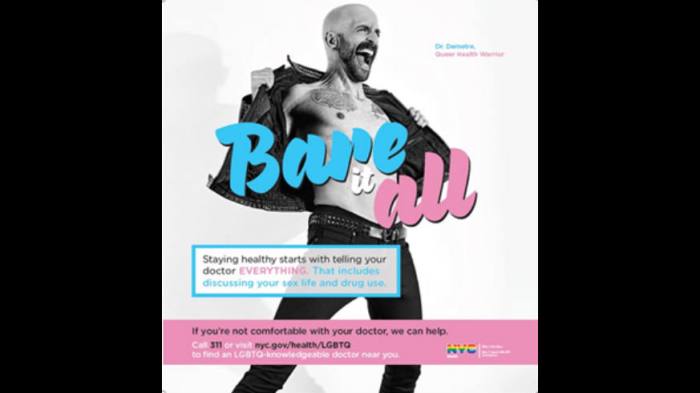With information blasting us in the face 24/7, we know all about sexually transmitted infections (STIs) — gonorrhea, syphilis, chlamydia —but the numbers of infections have reached the highest reported levels in 30 years in New York City with similar numbers nationwide. What gives?
“In a good way, we’re victims of our own success,” Deputy Commissioner for Disease Control at the NYC Department of Health Dr. Demetre Daskalakis told us.
“There’s a lot going on that makes STDS more complicated,” Daskalakis added. “Back in the 90s, when we were talking about HIV being a death sentence, the stakes were a lot higher.”
The best way to ensure you get effective health care is to be open and honest with your doctor: https://t.co/ZaUufkP6k9 pic.twitter.com/o8vI4RweoM
— Commissioner Bassett (@DrBassettDOHMH) July 13, 2017
According to Marketing Director for Sexual Wellbeing Nadja Korner, who works for Durex, one of the leading condom brands available, the stats are staggering.
“Half of sexually active people will get an STD … by the time they are 25,” Korner said. “It’s at an epidemic level.”
Korner added that out of recent CDC studies, half of all cases of STDs were diagnosed to people under the age of 25 and there will be an estimated 20 million STIs this year. She said it’s likely 10 million people under the age of 25 will have an STI in 2017.
You might be too young to have seen your friends die in the 80s or 90s, but STIs are still no joke. With so much focus on HIV and AIDS, which are now survivable, New York wants to remind the public that there are other infections that can cause damage to other parts of your body.
Syphilis in New York
“Syphilis is not an infection that is without complications,” Daskalakis explained. Why is he talking about such an “old fashioned” disease that’s only alluded to in Broadway musicals set in the olden days?
“We’re concerned about this obviously because that’s our job,” Daskalakis told us, “but the most concerning … is for syphilis. There is a 150 percent jump in the number of cases from 2005-2015” in New York City. The numbers are similar in the rest of the country.
Syphilis symptoms
Syphilis is an STI that can cause serious health problems if it is not treated. In 2015, total case counts and rates for reported syphilis were the highest recorded since 1994, according to the CDC.
Syphilis is called the “Great Pretender” since it can go undetected and get passed around) for years. When the infection becomes symptomatic, sores appear wherever the infection entered the body. The less painful anal or vaginal sores can easily go unnoticed.
As the infection progresses, rashes turn into hair loss, muscle fatigue, lesions, weight loss and swollen lymph nodes.
New relationship? Get checked at our Sexual Health Clinics: https://t.co/pKTGNr17XO pic.twitter.com/w8QY0SPcd1
— Commissioner Bassett (@DrBassettDOHMH) July 7, 2017
The next two stages of syphilis can take 10 to 30 years to appear and can be fatal. Syphilis affects organs like the brain, nerves, eyes, heart, blood vessels, liver, bones, and joints. The final stage can cause altered behavior, difficulty coordinating muscle movements, paralysis, blindness and dementia.
Syphilis can be easily passed from mother to fetus but is completely avoidable, Daskalakis said. Syphilis can also easily increase the likelihood of HIV infection.
STD prevention and testing
“We think that about 35 to 40 percent [of sexually active patients] report being consistent” and use condoms with every sexual interaction, Daskalakis explained. Korner advised that a condom is the only way to prevent STIs.
“We also know that most [sexually active people] don’t know they have an STD and they don’t get tested so they share that STD,” Korner said, adding that it is Durex’s duty to educate and encourage testing.
But some people are just not going to use a condom, even an ultra thin condom that promises increased sensitivity.
Daskalakis, who explained he lives in reality — not all patients are going to do what they are told, so you have to roll with it — said if he can get his patients to wear a condom sometimes, he’ll take the win, but they need to be tested at a high level of frequency.
Use some sort of protection against HIV and get screened for STIs frequently, he urged. Early identification means early treatment.
“Science moves faster than society and now we have to catch up. There’s not one way to prevent HIV and STIs,” Daskalakis explained. “It’s one big beautiful mess of testing, medicine, procedures…”
You can get tested at your general practitioner’s office, your OB/GYN, any number of sexual wellness clinics, or you can try a service like Biem and consult, test and get results without leaving home.
STD versus STI
Daskalakis said that he prefers to use STI versus STD because not all of the sexually transmitted illnesses are “diseases.” Actor Michael Douglas announced in 2013 that he had throat cancer (he later admitted he lied and actually had tongue cancer) brought on by human papilloma virus (HPV), a sexually transmitted infection that can remain asymptomatic for years. HPV can be transmitted via oral sex.
“Anecdotally, speaking as a medical provider, very few people use condoms for oral sex,” Daskalakis explained. “No matter if [the condom] is flavored or not, try to work in that space of reality; if you use it, test it. If you use your mouth for oral sex, you need to get it tested.”
Durex, as well as other condom makers, offers products like tropical flavored condoms designed to make sucking on latex less of a turn-off.
Thanks, @Durex_USA! I do love tropical flavors. haha #safersex pic.twitter.com/ejTa5Dds1G
— Kimberly M. Aquilina (@KimESTAqui) July 18, 2017



















